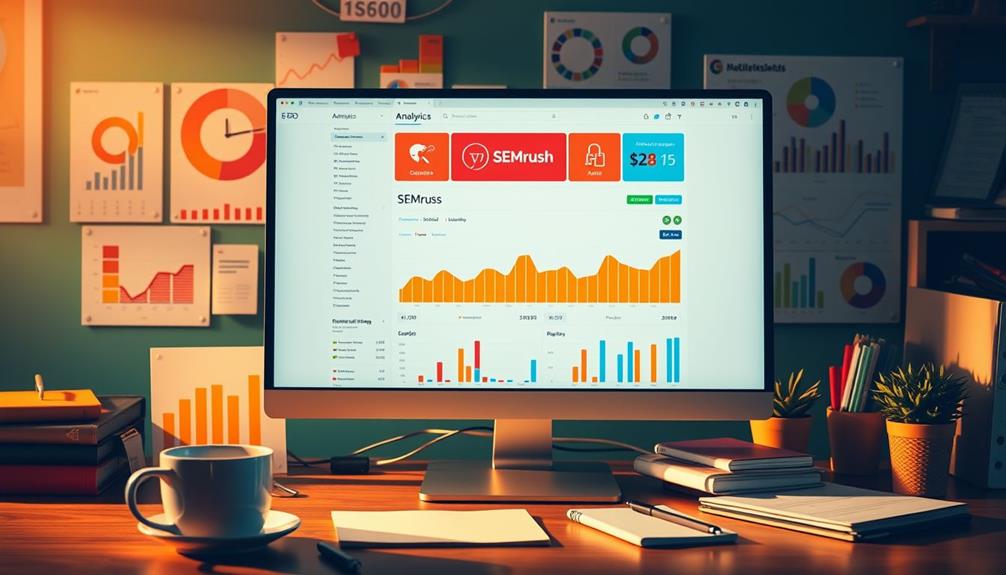Are you the proprietor of an independent bookstore seeking ways to enhance your enterprise? Search no more! This piece will uncover the proven Google Ads tactics we’ve employed to assist numerous entrepreneurs like yourself to flourish in the digital shopping era.
From understanding the basics to scaling your campaign for growth, we’ve got you covered. So grab a pen and paper, because by the end of this article, you’ll be well on your way to mastering the art of bookstore advertising with Google Ads.
Let’s get started!
Key Takeaways
- Determine ad budget: Allocate resources effectively for optimal results
- Optimize ad targeting: Reach the right audience and maximize return on investment
- Craft compelling ad copy: Highlight unique selling points and include clear call-to-action
- Analyze performance metrics: Use data-driven insights to refine ad targeting strategies
Understanding Google Ads Basics
In this article, we’ll explore the basics of Google Ads to help independent sellers boost their bookstore sales. Understanding Google Ads is crucial for achieving success in online advertising.

One important aspect to consider is the bidding strategy. Google Ads offers several bidding strategies that allow sellers to optimize their ad campaigns based on their goals. Some popular bidding strategies include manual cost-per-click (CPC), target cost-per-acquisition (CPA), and enhanced cost-per-click (ECPC). By selecting the right bidding strategy, sellers can effectively manage their budget and maximize their return on investment.
Another key element in Google Ads is ad scheduling. Ad scheduling allows sellers to control when their ads are shown to potential customers. By analyzing historical data and understanding customer behavior, sellers can determine the most effective times to display their ads. This ensures that ads are shown when the target audience is most likely to engage with them, increasing the chances of conversion and maximizing the ad spend.
Budgeting is also a crucial aspect of Google Ads. Sellers need to set a budget that aligns with their advertising goals and financial capabilities. It’s important to regularly monitor and adjust the budget to ensure it’s being used effectively. By analyzing performance metrics such as click-through rates, conversion rates, and return on ad spend, sellers can make informed decisions about their budget allocation.
Setting Up Your Google Ads Account
Now that we understand the basics of Google Ads, it’s time to set up our account and get started with our bookstore’s advertising campaign.

In this section, we’ll discuss the essential steps for setting up your Google Ads account, including:
- Creating an account
- Defining your campaign goals
- Setting your budget
We’ll also explore strategies for optimizing ad targeting to reach the right audience and maximize your bookstore’s visibility and sales.
Let’s get started and make the most out of Google Ads for our independent bookstore!
Account Setup Essentials
To set up our Google Ads account for optimal performance, we’ll need to follow a few essential steps:

- Choose the right campaign type: Select the campaign type that aligns with your advertising goals, whether it’s driving website traffic, generating leads, or increasing sales.
- Define your target audience: Identify your ideal customers and create detailed customer personas. This will help you tailor your ads and messaging to reach the right people at the right time.
- Set a realistic budget: Determine how much you’re willing to spend on advertising and allocate your budget strategically. Consider using Google’s automated bidding strategies to optimize your ad spend.
- Craft compelling ad copy: Write engaging and persuasive ad copies that highlight the unique selling points of your bookstore. Use relevant keywords and include a clear call-to-action to drive conversions.
By following these account setup best practices and optimizing your ad budget, you’ll be well on your way to reaching your advertising goals.
Now let’s dive into the next section about optimizing ad targeting to further enhance your campaign’s performance.
Optimizing Ad Targeting
Let’s dive into the process of optimizing ad targeting and setting up your Google Ads account for maximum effectiveness.
When it comes to ad targeting, two key factors to consider are your ad budget and ad scheduling.

First, determine your ad budget – the amount you’re willing to spend on advertising. This will help you allocate your resources effectively for optimal results.
Next, consider ad scheduling, which allows you to choose specific days and times to run your ads. By analyzing data and understanding your target audience’s behavior, you can schedule your ads to reach them when they’re most likely to engage.
This strategic approach ensures that your ads are seen by the right people at the right time, maximizing your chances of success.
Conducting Keyword Research for Bookstores
When it comes to conducting keyword research for bookstores, we need to focus on targeting niche book genres to attract the right audience.

By optimizing for localized keywords, we can increase the visibility of our bookstore in specific regions or cities.
Additionally, implementing long-tail keyword strategies will help us capture more specific search queries and improve our chances of reaching customers who are actively looking for the books we offer.
Targeting Niche Book Genres
We frequently conduct keyword research for our bookstore to target niche book genres and improve our Google Ads strategies as independent sellers. By targeting specific book genres, we can better connect with our target audience and increase the visibility of our bookstore.
Here are four key strategies we use for targeting niche book genres:

- Identify popular keywords: We research popular keywords related to specific book genres to understand what potential customers are searching for.
- Focus on targeting young readers: We prioritize targeting keywords that appeal to young readers, such as ‘children’s books’ or ‘young adult fiction,’ to attract our desired demographic.
- Promote local authors: We use keywords that highlight local authors and their works to attract readers who are interested in supporting local talent.
- Utilize long-tail keywords: We incorporate long-tail keywords, such as ‘historical mystery novels’ or ‘sci-fi books set in space,’ to target niche book genres and reach a more specific audience.
Localized Keyword Optimization
To further enhance our Google Ads strategies as independent sellers targeting niche book genres, we delve into the realm of localized keyword optimization for bookstores. Localized keyword targeting is a crucial aspect of geographical ad optimization, as it helps us reach our target audience more effectively.
By incorporating location-specific keywords in our ad campaigns, we can attract customers who are actively searching for books in their area. This strategy allows us to tap into the local market and increase foot traffic to our physical stores.
To conduct effective keyword research for bookstores, we can use tools like Google Keyword Planner and Google Trends to identify popular search terms related to our bookstore’s location and niche genres. By optimizing our ads with these localized keywords, we can maximize our visibility and drive more targeted traffic to our stores.
Long-Tail Keyword Strategies
For effective long-tail keyword strategies in conducting keyword research for bookstores, we rely on using tools like Google Keyword Planner and Google Trends. These tools help us identify the most relevant and specific keywords that will attract the right audience to our bookstore.

Here are four key steps to optimize long tail keyword research and ad campaigns:
- Identify niche topics: Focus on specific genres, authors, or book-related topics that are unique to your bookstore. This will help you target a more specific audience and stand out from the competition.
- Use long-tail keywords: Long-tail keywords are longer, more specific phrases that have lower search volume but higher conversion rates. Incorporate these keywords into your website content, blog posts, and ad campaigns to attract highly targeted traffic.
- Analyze search volume and competition: Use Google Keyword Planner to determine the search volume and competition level for each keyword. Choose keywords with moderate search volume and low competition to maximize your chances of ranking higher in search results.
- Monitor and refine: Continuously monitor the performance of your long-tail keyword campaigns. Analyze the click-through rates, conversion rates, and other metrics to identify areas for improvement and make necessary adjustments.
Creating Compelling Ad Copy
Crafting compelling ad copy is essential for independent sellers looking to boost their presence and sales on Google Ads. Writing compelling ads requires the use of effective ad copy techniques that grab the attention of potential customers and persuade them to take action.
One technique is to focus on the unique selling points of your products or services. Highlight what sets you apart from the competition and why customers should choose you. Use persuasive language and emphasize the benefits your customers will gain by purchasing from you.
Another technique is to create a sense of urgency. Limited-time offers, exclusive deals, or promotions can entice customers to click on your ad and make a purchase. Incorporate action-oriented words like ‘limited time,’ ‘exclusive,’ or ‘today only’ to create a sense of urgency and encourage immediate action.

Additionally, using emotional appeals can be highly effective in creating compelling ad copy. Tap into the desires, fears, or aspirations of your target audience to create a connection and evoke an emotional response. This can help to establish a strong bond with potential customers and increase the likelihood of conversion.
Optimizing Landing Pages for Conversions
We optimize landing pages to increase conversions. Conversion rate optimization is crucial for any online business, including independent sellers in the bookstore industry. By optimizing landing pages, we can improve the chances of turning website visitors into customers.
Here are four strategies for optimizing landing pages:
- Clear and compelling headlines: A strong headline grabs the attention of visitors and clearly communicates the value proposition of your bookstore. Use persuasive language to entice visitors to stay on the page and explore further.
- Simple and intuitive navigation: Make it easy for visitors to find what they’re looking for. Use clear navigation menus and avoid clutter. Ensure that important information, such as contact details and product categories, are easily accessible.
- Engaging and relevant content: Provide valuable content that’s tailored to your target audience. Showcase your bookstore’s unique selling points, such as curated book collections or personalized recommendations. Use persuasive language and visuals to engage visitors and keep them interested.
- A/B testing landing pages: Test different variations of your landing pages to identify what works best for your audience. Experiment with different layouts, colors, and call-to-action buttons. Analyze the data to make data-driven decisions and continually improve your conversion rates.
Targeting the Right Audience With Google Ads
To effectively target the right audience with Google Ads, it’s essential that we conduct thorough research and analysis of potential customers. By understanding our target audience’s demographics, interests, and behaviors, we can create more relevant and impactful ads that drive results. This allows us to improve ad relevancy and increase the likelihood of conversions.

One way to gather valuable insights about our target audience is through keyword research. By identifying the keywords and phrases our potential customers are using to search for products or services, we can align our ads with their search intent. This helps us reach the right people at the right time, increasing the chances of them clicking on our ads.
Additionally, we can use audience targeting options provided by Google Ads to further refine our targeting. This includes targeting based on demographics, interests, and behaviors. For example, if we’re selling books, we can target people who’ve shown an interest in reading or specific book genres.
To measure the success of our targeting efforts, we need to track key metrics such as click-through rates (CTR), conversion rates, and return on ad spend (ROAS). These metrics provide valuable insights into the performance of our campaigns and enable us to make data-driven optimizations.
Monitoring and Analyzing Performance Metrics
By analyzing key performance metrics, we can gain valuable insights into the effectiveness of our Google Ads campaigns and make data-driven optimizations. Tracking conversions and analyzing click-through rates are essential steps in monitoring and analyzing the performance of our campaigns. Here are four ways to effectively monitor and analyze performance metrics:

- Set up conversion tracking: By implementing conversion tracking, we can measure the number of purchases, form submissions, or any other actions that are valuable to our business. This helps us understand which keywords and ads are driving the most conversions.
- Analyze click-through rates (CTR): CTR is a metric that measures the percentage of people who click on our ads after seeing them. By analyzing CTR, we can determine the relevance and effectiveness of our ad copy and make necessary adjustments to improve performance.
- Monitor cost per conversion: Cost per conversion shows us how much we’re spending for each conversion. By keeping an eye on this metric, we can identify opportunities to optimize our campaigns, such as adjusting bidding strategies or refining targeting.
- Track return on ad spend (ROAS): ROAS measures the revenue generated for every dollar spent on ads. By tracking ROAS, we can identify which campaigns are driving the highest return and allocate our budget accordingly.
By consistently monitoring and analyzing these performance metrics, we can make data-driven optimizations to improve the effectiveness and efficiency of our Google Ads campaigns.
Now, let’s explore how to scale our campaigns for growth.
Scaling Your Google Ads Campaign for Growth
As we analyze the performance metrics of our Google Ads campaigns, it becomes evident that scaling our campaign for growth is the next crucial step for our independent bookstore. To achieve this, we need to implement effective scaling strategies and optimize our budget allocation.
One scaling strategy is to expand our keyword targeting. By identifying additional relevant keywords that our potential customers might use in their searches, we can increase our reach and attract more qualified traffic to our website. This can be done through thorough keyword research and analysis, as well as ongoing monitoring and adjustment of our keyword list.

Another strategy is to increase our budget strategically. Rather than simply allocating more funds across all campaigns, we can identify the top-performing campaigns and channels and prioritize them for budget optimization. By focusing our resources on the most effective channels, we can maximize our return on investment and drive more conversions.
Additionally, we can explore opportunities for remarketing. By showing targeted ads to users who’ve previously visited our website or engaged with our content, we can increase brand recall and encourage them to revisit and make a purchase. Remarketing can be done through Google Ads’ audience targeting features, allowing us to reach out to potential customers who’ve already shown interest in our bookstore.
Frequently Asked Questions
How Can I Determine My Budget for Google Ads?
When determining our budget for Google Ads, we consider factors like our marketing goals, target audience, and competition. It’s important to set a realistic budget that aligns with our objectives and maximizes our return on investment.
What Are Some Best Practices for Bidding on Keywords?
When it comes to bidding on keywords, we’ve found that optimizing ad copy and using negative keywords are key. These strategies help us maximize our budget and ensure our ads reach the right audience.

How Can I Track Conversions and Measure the Success of My Google Ads Campaign?
To track conversions and measure the success of our Google Ads campaign, we use key metrics like click-through rate, conversion rate, and cost per conversion. We optimize ad performance with tips and tricks for better results.
Are There Any Specific Strategies for Targeting Local Customers With Google Ads?
To target local customers with Google Ads, we utilize effective local SEO and geo-targeting strategies. By optimizing our ads with location-specific keywords and targeting specific geographic areas, we can reach the right audience and boost our bookstore’s visibility.
What Are Some Common Mistakes to Avoid When Running a Google Ads Campaign for a Bookstore?
Common mistakes to avoid when running a Google Ads campaign for a bookstore include not optimizing keywords, neglecting ad copy testing, and failing to target the right audience. These optimization techniques are crucial for success.
Conclusion
So there you have it, folks! With the power of Google Ads, independent bookstore owners can now reach a wider audience and boost their sales.

Just remember to conduct thorough keyword research, create compelling ad copy, and optimize your landing pages for conversions.
And don’t forget to monitor and analyze your performance metrics to fine-tune your campaign.
With these strategies in place, your bookstore will be skyrocketing to success in no time.
Happy advertising!











